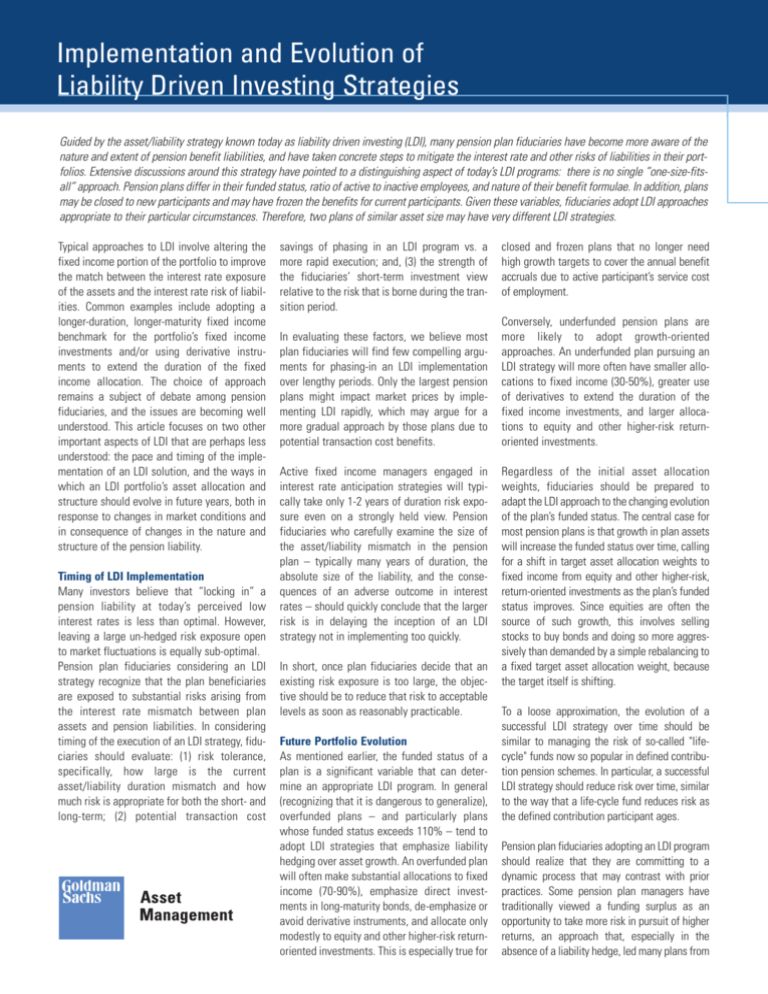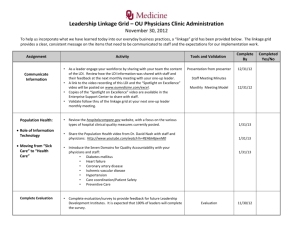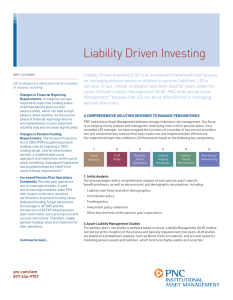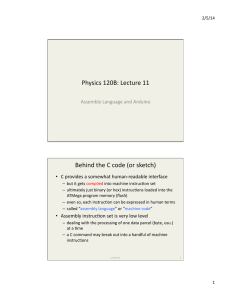
Implementation and Evolution of
Liability Driven Investing Strategies
Guided by the asset/liability strategy known today as liability driven investing (LDI), many pension plan fiduciaries have become more aware of the
nature and extent of pension benefit liabilities, and have taken concrete steps to mitigate the interest rate and other risks of liabilities in their portfolios. Extensive discussions around this strategy have pointed to a distinguishing aspect of today’s LDI programs: there is no single ”one-size-fitsall” approach. Pension plans differ in their funded status, ratio of active to inactive employees, and nature of their benefit formulae. In addition, plans
may be closed to new participants and may have frozen the benefits for current participants. Given these variables, fiduciaries adopt LDI approaches
appropriate to their particular circumstances. Therefore, two plans of similar asset size may have very different LDI strategies.
Typical approaches to LDI involve altering the
fixed income portion of the portfolio to improve
the match between the interest rate exposure
of the assets and the interest rate risk of liabilities. Common examples include adopting a
longer-duration, longer-maturity fixed income
benchmark for the portfolio’s fixed income
investments and/or using derivative instruments to extend the duration of the fixed
income allocation. The choice of approach
remains a subject of debate among pension
fiduciaries, and the issues are becoming well
understood. This article focuses on two other
important aspects of LDI that are perhaps less
understood: the pace and timing of the implementation of an LDI solution, and the ways in
which an LDI portfolio’s asset allocation and
structure should evolve in future years, both in
response to changes in market conditions and
in consequence of changes in the nature and
structure of the pension liability.
Timing of LDI Implementation
Many investors believe that “locking in” a
pension liability at today’s perceived low
interest rates is less than optimal. However,
leaving a large un-hedged risk exposure open
to market fluctuations is equally sub-optimal.
Pension plan fiduciaries considering an LDI
strategy recognize that the plan beneficiaries
are exposed to substantial risks arising from
the interest rate mismatch between plan
assets and pension liabilities. In considering
timing of the execution of an LDI strategy, fiduciaries should evaluate: (1) risk tolerance,
specifically, how large is the current
asset/liability duration mismatch and how
much risk is appropriate for both the short- and
long-term; (2) potential transaction cost
savings of phasing in an LDI program vs. a
more rapid execution; and, (3) the strength of
the fiduciaries’ short-term investment view
relative to the risk that is borne during the transition period.
In evaluating these factors, we believe most
plan fiduciaries will find few compelling arguments for phasing-in an LDI implementation
over lengthy periods. Only the largest pension
plans might impact market prices by implementing LDI rapidly, which may argue for a
more gradual approach by those plans due to
potential transaction cost benefits.
Active fixed income managers engaged in
interest rate anticipation strategies will typically take only 1-2 years of duration risk exposure even on a strongly held view. Pension
fiduciaries who carefully examine the size of
the asset/liability mismatch in the pension
plan – typically many years of duration, the
absolute size of the liability, and the consequences of an adverse outcome in interest
rates – should quickly conclude that the larger
risk is in delaying the inception of an LDI
strategy not in implementing too quickly.
In short, once plan fiduciaries decide that an
existing risk exposure is too large, the objective should be to reduce that risk to acceptable
levels as soon as reasonably practicable.
Future Portfolio Evolution
As mentioned earlier, the funded status of a
plan is a significant variable that can determine an appropriate LDI program. In general
(recognizing that it is dangerous to generalize),
overfunded plans – and particularly plans
whose funded status exceeds 110% – tend to
adopt LDI strategies that emphasize liability
hedging over asset growth. An overfunded plan
will often make substantial allocations to fixed
income (70-90%), emphasize direct investments in long-maturity bonds, de-emphasize or
avoid derivative instruments, and allocate only
modestly to equity and other higher-risk returnoriented investments. This is especially true for
closed and frozen plans that no longer need
high growth targets to cover the annual benefit
accruals due to active participant’s service cost
of employment.
Conversely, underfunded pension plans are
more likely to adopt growth-oriented
approaches. An underfunded plan pursuing an
LDI strategy will more often have smaller allocations to fixed income (30-50%), greater use
of derivatives to extend the duration of the
fixed income investments, and larger allocations to equity and other higher-risk returnoriented investments.
Regardless of the initial asset allocation
weights, fiduciaries should be prepared to
adapt the LDI approach to the changing evolution
of the plan’s funded status. The central case for
most pension plans is that growth in plan assets
will increase the funded status over time, calling
for a shift in target asset allocation weights to
fixed income from equity and other higher-risk,
return-oriented investments as the plan’s funded
status improves. Since equities are often the
source of such growth, this involves selling
stocks to buy bonds and doing so more aggressively than demanded by a simple rebalancing to
a fixed target asset allocation weight, because
the target itself is shifting.
To a loose approximation, the evolution of a
successful LDI strategy over time should be
similar to managing the risk of so-called "lifecycle" funds now so popular in defined contribution pension schemes. In particular, a successful
LDI strategy should reduce risk over time, similar
to the way that a life-cycle fund reduces risk as
the defined contribution participant ages.
Pension plan fiduciaries adopting an LDI program
should realize that they are committing to a
dynamic process that may contrast with prior
practices. Some pension plan managers have
traditionally viewed a funding surplus as an
opportunity to take more risk in pursuit of higher
returns, an approach that, especially in the
absence of a liability hedge, led many plans from
liabilitiessets
Often overlooked is how the LDI strategy should
evolve over time as a result of paying benefits
and/or because of successfully meeting the
asset growth targets. Planning for such an evolution is particularly important for closed and
frozen plans where benefit payments can be
larger than the combination of the annual accretion of the liability due to employee service and
interest costs. In these cases, and in the absence
of adverse market movements, the liability
shrinks over time and, under an LDI strategy, the
pension surplus grows over time (or, equivalently, the pension deficit shrinks).
In such instances, a policy of paying out benefit
payments preferentially from the portion of the
portfolio holding the equity and other higher-risk,
return-oriented investments acts to reduce
pension surplus volatility and increase the
liability hedge efficacy over time, while simultaneously maintaining or improving the plan’s
funded status.
We can illustrate with an example using a
hypothetical $1 billion pension plan, fully
funded today, pursuing an LDI strategy that
invests 30% in equity and other higher-risk,
return-oriented investments earning a targeted
8.5% annual return and 70% in fixed income
assets having a duration equal to that of liabilities and expected to earn 5% annually, which
matches the liability discount rate. In effect,
the LDI strategy is set up to hedge 70% of the
interest rate risk of the pension liability and the
assets as a whole are expected to grow at a rate
of approximately 1% in excess of the interest
cost of the liabilities. Absent distributions, the
funded status would be expected to improve
from fully-funded (100%) to 105% funded in five
years, the fixed income assets would be
expected to grow in line with liability accretion,
and the LDI strategy would continue to hedge
70% of the liability risk. For convenience, we
assume a closed and frozen plan, which is not
accruing any meaningful service costs.
In the more realistic case where regular distributions to pension beneficiaries are occurring, the
hypothetical plan’s future funded status and
liability hedge effectiveness will depend upon
how those distributions are funded. For illustration, we assume annual distributions of $75
million. If the distributions are funded 70% from
the fixed income assets and 30% from the equity
and other higher-risk, return-oriented investments, reflecting the initial asset allocation, then
the equity/bond split will deteriorate over time
from 30/70 initially to 35/65 after five years as a
result of the higher expected growth rate in the
equity and other higher-risk return-oriented
investments. Alternatively, if the distributions
are funded 60% from the fixed income assets
and 40% from the equity and other higher-risk
return-oriented investments, the equity/bond
split remains at 30/70, and the liability hedging
effectiveness improves from 70% initially to
75% after five years time reflecting the improvement in funded status.
Ideally, the distribution policy should reflect a
desire to hedge more of the liability risk as the
plan’s funded status improves. For example, if
distributions are even more preferentially funded
from the equity portion, say 50% from fixed
income and 50% from equity and other higherrisk return-oriented investments, then the liability
hedging effectiveness improves from 70%
initially to 80% after five years, the equity/bond
asset split moves from 30/70 initially to 25/75
after five years, and the plan’s funded status
Exhibit I: Illustrative Example
of LDI Strategy
1200
Present Value / Market Value ($ millions)
surplus to deficit early in this decade. In an LDI
program, a funding surplus should be viewed as
a prime opportunity to reduce risk.
Liability Present Value
Fixed Income Assets
Equity & Other Assets
1000
800
600
400
200
0
2008
2009
2010
2011
2012
2013
These examples are for illustrative purposes only and are not actual results. If any assumptions used
do not prove to be true, results may vary substantially.
would be expected to improve from fully-funded
(100%) to 106% funded after five years. [This
example is shown for illustration in Exhibit I.]
In summary, liability driven investing has been
embraced by the pension community and
pension plan fiduciaries are making independent decisions concerning the targeted level of
growth in the plan and the degree of risk exposure – generally seeking to maintain an excess
growth of plan assets over plan liabilities,
while substantially reducing the net interest
rate risk from liabilities. Once the decision is
made to pursue an LDI strategy, we see little
benefit from delaying its implementation,
recognizing at the same time that an LDI
strategy is a dynamic process and not a static
asset allocation. Over time, and as growth
targets are realized, an LDI strategy will generally seek increasing risk reduction as the plan
becomes more fully funded. Important in this
process is the planning of how to meet future
benefit payments, with benefits generally paid
out preferentially from the equity and other
higher-risk, return-oriented investments.
For more information, visit
gsamldi.gs.com
This material is provided for educational purposes only and should not be construed as investment advice or an offer or solicitation to buy or sell securities. Opinions expressed are current opinions as of the
date appearing in this material only. No part of this material may, without GSAM’s prior written consent, be (i) copied, photocopied or duplicated in any form, by any means, or (ii) distributed to any person that
is not an employee, officer, director, or authorized agent of the recipient. This information discusses general market activity, industry or sector trends, or other broad-based economic, market or political
conditions and should not be construed as research or investment advice. This material has been prepared by GSAM and is not a product of the Goldman Sachs Global Investment Research (GIR) Department.
The views and opinions expressed may differ from those of the GIR Department or other departments or divisions of Goldman Sachs and its affiliates. Investors are urged to consult with their financial advisors
before buying or selling any securities. This information may not be current and GSAM has no obligation to provide any updates or changes. The strategy may include the use of derivatives. Derivatives often
involve a high degree of financial risk because a relatively small movement in the price of the underlying security or benchmark may result in a disproportionately large movement in the price of the derivative
and are not suitable for all investors. No representation regarding the suitability of these instruments and strategies for a particular investor is made.
Copyright © 2008, Goldman, Sachs & Co. All rights reserved. (10506.OTHER)










